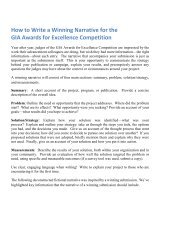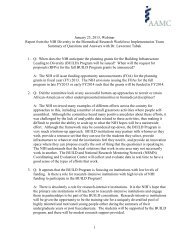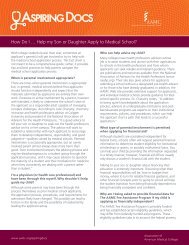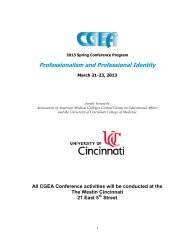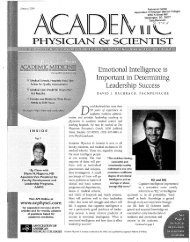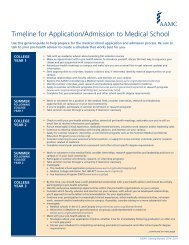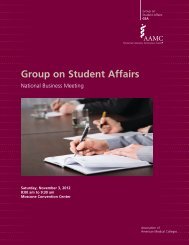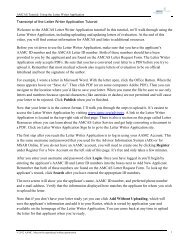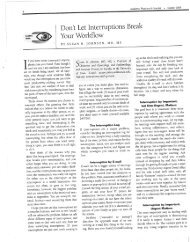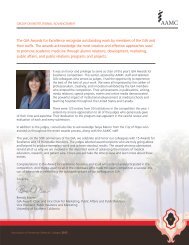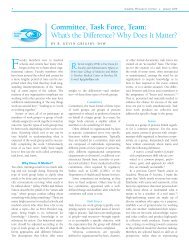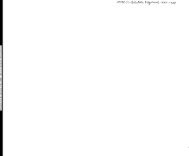2013 Poster Session Summaries - AAMC
2013 Poster Session Summaries - AAMC
2013 Poster Session Summaries - AAMC
Create successful ePaper yourself
Turn your PDF publications into a flip-book with our unique Google optimized e-Paper software.
medical educators through: 1) training in the science of medical education, theoretical frameworks, and<br />
principles; 2) experiential learning through formal teaching experiences with reflection and feedback; 3)<br />
scholarship in medical education via curriculum development or medical education research; 4) mentorship<br />
by faculty with experience in medical education leadership or scholarship. The four components of the<br />
certificate program would be longitudinally integrated into the medical school curriculum through required<br />
workshop sessions, teaching experience, longitudinal mentoring and opportunities in medical education<br />
scholarship and research. Students also have the opportunity to enroll in a 2-week course, entitled Frontiers<br />
in Medical Education, to learn about the most recent scientific advances in medical education methodologies<br />
and research. Participants in the certificate program will be followed through residency and beyond to<br />
assess the effectiveness of this program and its contribution to their training and long term outcomes. It is<br />
expected that this program will provide medical students with much-needed training making them better<br />
educators, both as house officers and eventually as attending physicians.<br />
Dania Daye, MS4, Jonathan McNeill, MS4, Jennifer Kogan, M.D.<br />
Perelman School of Medicine at the University of Pennsylvania<br />
RUSH MEDICAL COLLEGE OF RUSH UNIVERSITY MEDICAL CENTER [<strong>Poster</strong> # 27]<br />
Program/Project Title: Student Tutors in the Anatomy Lab<br />
Presenter(s): Jennifer Olson<br />
Email: jlolson83@gmail.com<br />
While many schools employ students to tutor the classes below them, Rush has uniquely extended the<br />
program into the anatomy lab. Free tutoring is offered Monday through Thursday at two evening sessions or<br />
on Friday afternoon. Over thirty M2s volunteer to again don their scrubs and lead small group hands-on<br />
tutoring sessions. Students generally work in groups of two to four to divide that week’s anatomy curriculum.<br />
They arrive early to find an example cadaver, clean up the dissection, and then review structures and related<br />
information as the M1s rotate between tutors. They also organize a practice anatomy practical exam for<br />
every block which involves tagging structures and providing a key. <strong>Session</strong>s are well-attended with more<br />
than 90% of each class participating. Many cite the program’s value in that students can pass down memory<br />
tools and often-asked exam questions. It also eases anxiety about the practical exam and provides for<br />
mentorship opportunities by facilitating inter-class communication. The University organizes the paid<br />
employment of the students as tutors and announces its availability to the new class, but limits its<br />
involvement there. Tutors submit attendance sheets with participants’ signatures as time sheets which also<br />
functions as quality control as pupils will vote with their feet. Cost to the university is minimal, 20-30 tutors<br />
work 4-10 hours per month at $10/hour. The simple model of this program could be easily reproduced at<br />
other schools for the benefit of even more first year students.<br />
RUSH MEDICAL COLLEGE OF RUSH UNIVERSITY MEDICAL CENTER [<strong>Poster</strong> # 28]<br />
Program/Project Title: Humanities in Medicine<br />
Presenter(s): Jennifer Olson<br />
Email: Erica_J_Huelsmann@rush.edu<br />
At Rush Medical College, we recently integrated a unique “Humanities in Medicine” elective course for a<br />
small group of first year medical students. We would like to share the unique qualities of our program, the<br />
expected and unexpected responses of faculty and students, and future directions with others.<br />
General Course Description:<br />
This elective was an 18-session course that examined how empathy, observation and interpretation impact<br />
one’s experience of literature and the arts. Particular attention was paid to the ways in which observation<br />
and engagement with the arts parallels observation and engagement in patient care. Individual sessions<br />
focused on the role of temporal and professional perspective in describing medical events, differences and<br />
similarities in observational skills in the arts and medicine and the use of movement and drama exercises to<br />
examine how one experiences and is experienced by others. Course activities included museum visits,<br />
movement activities, acting exercises and reading and writing about selected works of literature.<br />
16



